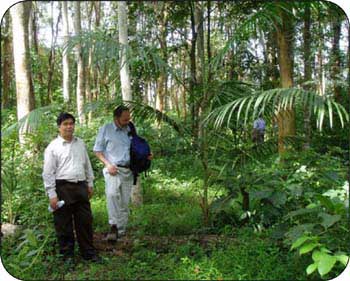Farm forestry is a means of fostering tree growing in rural landscapes in a way that benefits both the local and broader communities. Farm forestry is now being widely promoted throughout the region.
For example, Viet Nam has embarked on its Five Million Hectare Reforestation Program which relies heavily on farm forestry, and Thailand also has a similar national programme to assist farmers to plant more trees in community forests.

Tree growing will be more attractive to farmers... this is when they can obtain a financial return before the trees mature.
In some heavily populated but degraded watersheds, farm forestry may be the only way that extensive reforestation may be possible.
Farm forestry may also be attractive in areas where populations have drifted to cities and rural population densities are declining, such as in Peninsular Malaysia. This means the demand for agricultural land may decrease over time, thereby increasing the availability of land for reforestation.
Farm forestry requires a different set of silvicultural prescriptions than does large-scale, industrial plantation forestry (Herbohn et al. 2001). Trees can be financially profitable for farmers, but they are also a higher risk crop (because of the long rotation and unknown future markets). At the same time, simple monocultures of long-lived tree species may not be attractive to farmers needing to grow their own food and to provide for themselves.
Left to themselves, many farmers who do grow trees usually use more than one tree species and commonly under-plant these with faster growing food or cash crops that will provide an earlier financial return than the trees. Such farmers may regard the trees largely as a form of insurance or a "silvicultural bank account" for special occasions.
But not all farmers are necessarily interested in tree growing. This may be because they see no advantages in doing so, or because they are unaware of the opportunities that tree growing may provide. If farm forestry is to be encouraged for environmental reasons (e.g. watershed protection) and for the benefit of the wider society, then farmers (or absentee landowners) will need to be given incentives, compensation and appropriate assistance to motivate desired actions (Le Trong Cuc and Rambo 2001).
One form of assistance will be silvicultural knowledge and, in most situations, this will be different from that generally used by larger industrial plantation companies. Farmers may require technical assistance in:
identifying potential future market opportunities (including markets for environmental services);
identifying the most appropriate species to use in their environmental and economic circumstances (many farmers may opt for commonly planted and fast-growing exotic species even though the sites may not be appropriate and the future financial returns from these may be low);
securing seeds or high-quality seedlings;
determining when to plant and how to grow and manage their trees; and
marketing their infrequent and small production volumes.
Some farmers may recognize the value and importance of traditionallyused tree species and other non-timber species (although some migrant farmers may not have relevant traditional knowledge for the sites they now occupy). But there may be alternatives, including other exotic species that are more suitable in the (degraded) sites available for planting.

Multi-species plantations... these may be of considerable importance, especially in farm forestry.
As the supply of timber from natural forests declines, the economic opportunities for farmers able to grow some of the species once supplied by these forests may be increasing. This means there is a need for a wider array of silvicultural knowledge, better advice on market opportunities (perhaps including using sellers' cooperatives to match the market power of traders or log buyers) and better ways of communicating this knowledge to farmers in rural areas. The other forms of assistance needed to promote farm forestry are:
long-term (preferably permanent) land tenure;
financial loans with low interest rates, flexible repayment schemes, micro finance, tax credits, taxation assistance, etc;
payment schemes for the ecological services provided by farm forests to the rest of society.
Ways of repaying farmers for ecological services such as watershed protection, carbon sequestration (e.g. payment for carbon credits has been used to fund enrichment planting in secondary forests in Sabah) and perhaps even biodiversity protection, need to be explored. This latter case might apply, for example, to farmers living in or around protected areas.
Studies in Costa Rica have revealed that payments for ecological services could provide a significant benefit to household incomes, although the transaction costs are high. This could limit the attractiveness of these payments to smaller farmers (Miranda et al. 2003).
Transaction costs are less when the areas involved are larger. Hence the market for ecological services such as carbon sequestration could also have the effect of concentrating land ownership which might be undesirable for social reasons (May et al. 2004). Any market for ecological services will obviously necessitate clearly defined land tenure.
It is important to note that some farmers or communities will also be motivated to plant trees by factors other than just timber production. For example, the Forest Restoration Research Unit at Chiang Mai University has identified several northern Thailand communities that are willing to attempt forest restoration to enhance biodiversity. In this case, the motivation for planting has less to do with immediate financial gain and is rather more complex, involving community pride, local politics and other issues. In other locations, the motivation for tree planting may be simply to affirm land ownership.